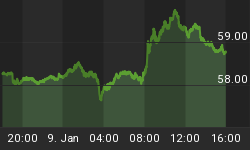Introduction
The price cycle is the path prices take from low to high and back to low again. I use investor sentiment to define the price cycle. At market lows, investors are typically bearish, and at market highs, they are overly bullish. For 6 weeks now investors have been extremely bullish, and while it does pay to run with the bulls, investors will eventually bail on the markets marking an end to the up portion of the price cycle. This is what happened last week as the market finished lower for a second consecutive week!
So investor sentiment has rolled over as the "dumb money" indicator (see figure 2 below) has crossed below the upper trading band. Investors are no longer extremely bullish. The price cycle has likely peaked, and the next buying opportunity should come when investors turn extremely bearish in their outlook. The price cycle "dictates" that every sell signal should be followed by a buy signal and so forth. But before we get to that eventuality (i.e., the next buy signal), we need to exit our current equity positions. When I backtested the "best" exit strategy, there were two things that I found. One, it was best to wait for sentiment to unwind (like it has with the "dumb money" indicator crossing below the upper trading band), and two, we had to wait for the first week where the closing price was greater than the opening price. This is what we determined as "best" as in optimal, and it should not be construed as meaning this is what is going to happen this week or next. In essence, you need to be selling strength or the "dead cat" bounce that is likely to happen as prices are short term oversold.
We turned bullish 21 weeks ago when investors were extremely bearish on the stock market. This marked the bottom of the current price cycle and the lows of the current market move. We are now looking to sell that position as we believe the price cycle has peaked. It is our expectation that lower prices will be required to turn investors bearish. This will provide us with another buying opportunity which will most likely reset the price cycle once again. Wash, rinse, repeat. There you have it.
This market narrative, whatever it may be, is only starting to play out. There will be both bullish and bearish talk. The investing mindset remains such that investors belief in the Federal Reserve or other central banks has yet to be shattered. I think that moment is a long ways off, and will coincide with a technical failure in the markets. So what do I mean by this? The markets will sell off at some point in the future and investor sentiment will turn bearish. We will become buyers when everyone else is bearish. The markets will lift like they do 80% of the time under such dynamics, and there might even be an announcement by the Fed that supports the markets and investors beliefs that the Fed has their back. But for whatever reason, the bounce will fail and the markets will move (crash?) lower not only violating those important technical levels that brought in the buyers in the first place but also destroy the notion that the Fed has control. That's how I see a top in the markets. For now, I view the current top as an intermediate term top. It is too early to determine if this is going to be "the top".
As a reminder, we have moved our stop loss up to SP500 1706.92.
The Sentimeter
Figure 1 is our composite sentiment indicator. This is the data behind the "Sentimeter". This is our most comprehensive equity market sentiment indicator, and it is constructed from 10 different variables that assess investor sentiment and behavior. It utilizes opinion data (i.e., Investors Intelligence) as well as asset data and money flows (i.e., Rydex and insider buying). The indicator goes back to 2004. (Editor's note: Subscribers to the TacticalBeta Gold Service have this data available for download.) This composite sentiment indicator moved to its most extreme position 10 weeks ago, and prior extremes since the 2009 are noted with the pink vertical bars. The March, 2010, February, 2011, and February, 2012 signals were spot on -- warning of a market top. The November, 2010 and December, 2012 signals were failures in the sense that prices continued significantly higher. The current reading is neutral but heading towards bearish (as in too many bullish investors).
Figure 1. The Sentimeter
















